How are developed industry and specialized solutions for 1C: ERP
In this article we will try to tell how with the help of remote and geographically distributed teams we have established the process of producing application solutions that expand the functionality of our product "1C: ERP Enterprise Management 2".
On the basis of our technological platform "1C: Enterprise 8", we ourselves, the 1C company, produce about 20 solutions of various caliber - from "Management of our company", "1C: Accounting" of different editions (from "Simplified" to "Corporate" ) until our most functionally rich solution is “1C: ERP Enterprise Management 2”.
“1C: ERP 2” is a solution that automates most of the processes of multi-disciplinary enterprises. But there are whole classes of tasks and industry characteristics that require more detailed study than it is in “1C: ERP 2” - trade, logistics, warehouse management, construction, agriculture, etc. It is not appropriate to include this functionality in a typical solution, since This will complicate the work of most users. In addition, we ourselves may not have enough resources to fully implement the required functionality.
So, we are faced with the task of creating industry / specialized solutions that:
')
We solve this problem as follows:
Products that extend the functionality of "1C: ERP", are produced in the framework of the project "1C-Together."
Under the 1C-Together project, the product is created by the partner of 1C, but the copyright holder is 1C. We ourselves define the requirements for the product and control its quality.
The procedure for developing joint solutions:
We monitor the quality level of our decisions. Thus, according to the survey data, the quality of the products themselves, the work of the partner, and the developer consulting line are evaluated:
From the point of view of the concept and architecture, “1C: ERP” is a completely new product compared to its predecessor, “1C: Manufacturing Enterprise Management”. One of the key differences of the new solution is the primacy of the management functions. In developing the line of industry and specialized solutions, it was important to support this in the 1C-Together solutions. Particular attention was paid to the problems of integrability of solutions among themselves and with “1C: ERP”, the possibility of building a unified information system consisting of a set of modules with a key integration core - “1C: ERP”.
The goal is a single seamless information management system built on the basis of “1C: ERP” and other solutions of “1C: Enterprise 8”:
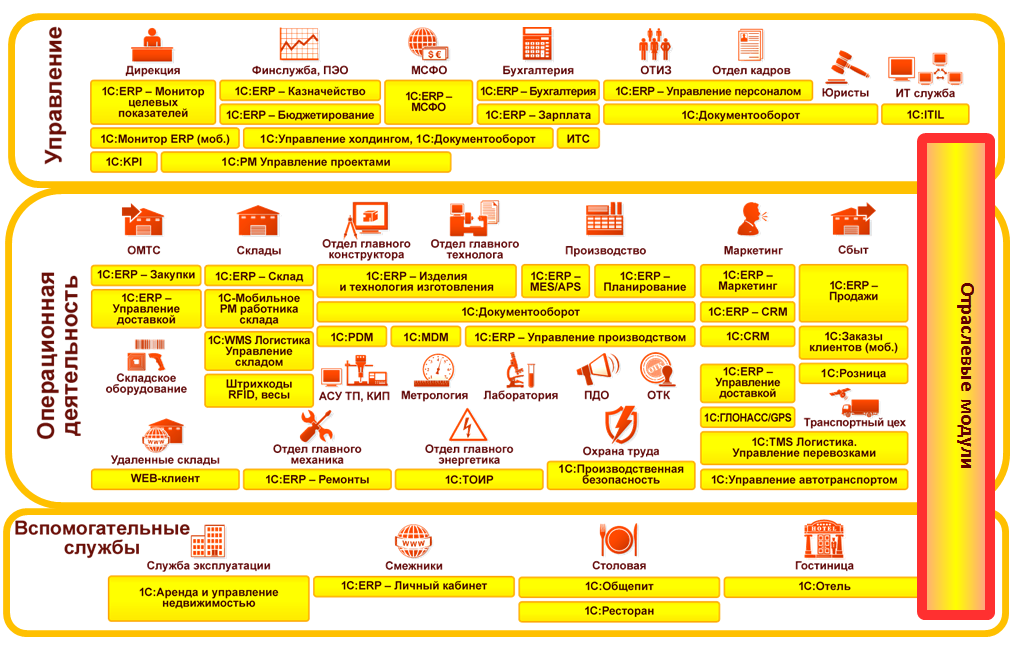
The concept of a modular approach in the architecture of solutions based on 1C: ERP was developed. The concept defines the principles of development, unification and integration of various configurations within a unified management and accounting system.
All solutions within the 1C-Together program, expanding the capabilities of 1C: ERP, should follow the concept of a modular approach. The key objectives of the modular approach are:
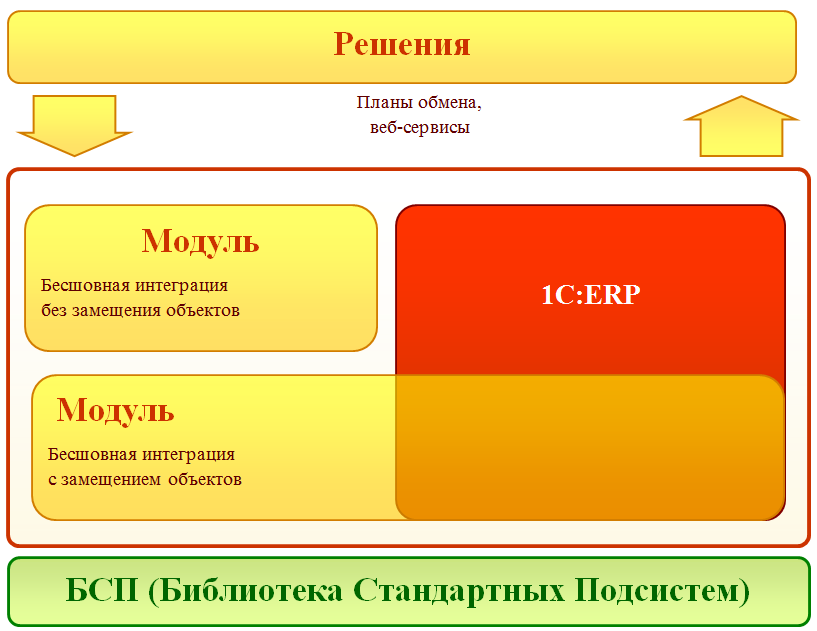
At the time of this writing, the number of already released line solutions is 31 (18 development partners), taking into account development plans, in Q2 2017. the number of solutions will reach 52 (24 development partners).
The work on the project involves geographically distributed and weakly related development teams. So, today in our work:
To control the quality of team work, we regulated the general principles of interaction between teams and projects:
A round table for developers of solutions "1C-Together" is held annually, this event discusses problems and proposals, organizes platforms for communication and interaction between development partners and developers of 1C: ERP.
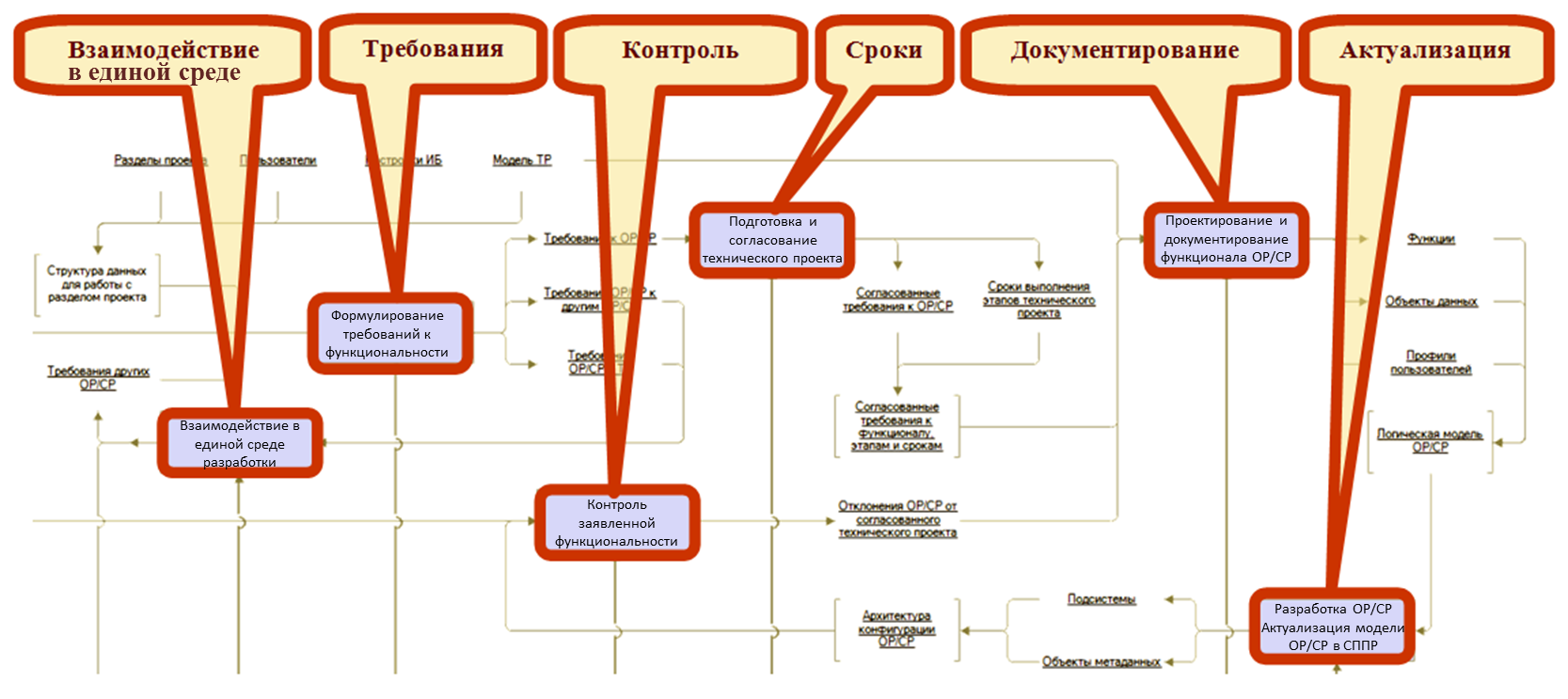
View the image in full size
All solution developers interact through the product "1C: Design System for Applied Solutions" (abbreviated as DSS). DSS helps to design application solutions on the 1C: Enterprise platform and allows servicing the tasks of the full software development cycle - gathering requirements, controlling changes, documenting, bug tracking, etc. DSS is designed as a configuration on the 1C: Enterprise 8 platform.
DSS can be used as a tool for designing new information systems developed in the 1C: Enterprise 8 environment, as well as for describing and documenting existing systems developed previously without using DSS.
We have chosen DSS as the most convenient and suitable for our tasks and corresponding to the requirements we have put forward for the CASE-tool:
As part of the development of the Solution Line for 1C: ERP, all project participants have access to a common DPR PR / CP cloud database, the work with which is determined by the regulations:
Goals
Tasks
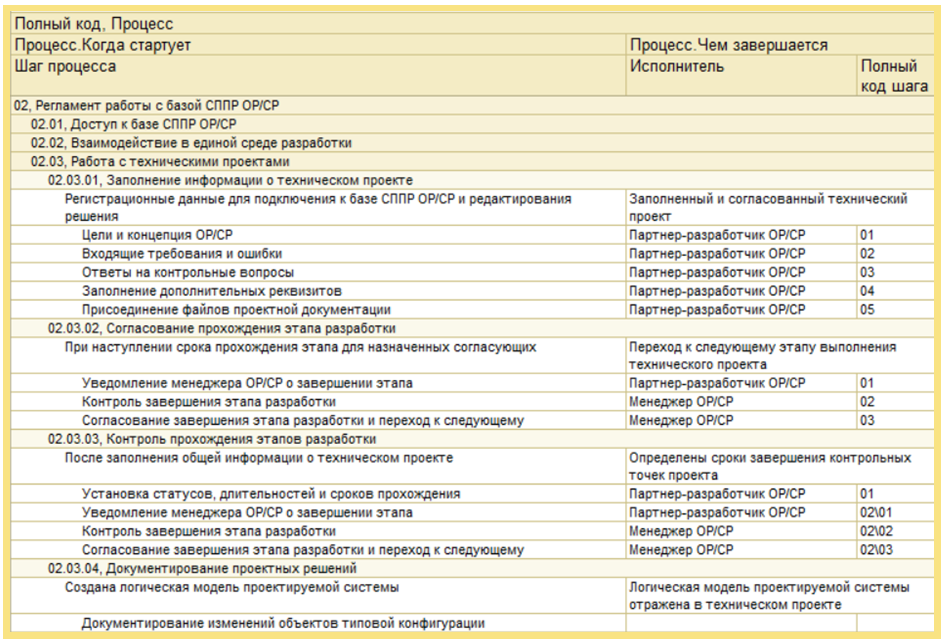
The whole project is divided into functional areas (sections of the project), each section is supervised by the head of the direction from the "1C". Sections are filled with the functionality of solutions (products), and:
For solutions that implement the functionality of a single section of the project, special requirements are placed on the possibility of integration.
For the designed functionality, corresponding technical projects are created, with the appointment of those responsible on the part of the development partner. Within the framework of one technical project, it is possible to release at once several options for the delivery of functionality (in fact, the products themselves).
Each technical project is assigned a planned deadline for completion (managed and supervised by the head of the direction), and deadlines are set for the implementation of the technical project.
The development partner specifies the timing of the control points within the overall duration of the project. When the deadline for performing one of the steps is exceeded, the information falls under the control of the responsible manager. Also the responsible manager sees the deadlines for the implementation of each stage (including overdue). Each stage is completed by the agreement of the control point responsible.
We do not set goals to manage the development process on the side of partners. Each partner uses its own established methodology in the team. We control only the terms of the control points that are important for us and adjust the results with the necessary standards and regulations, and we also control their familiarity with them.
Within the framework of technical projects, not only work on the development of new functionality is planned and carried out, but also load tests, standardization of general functionality, minimization of changes to metadata objects of typical configuration.
In the base of the DSS PR / CP, the functionality of all solutions of the line is described in one project. At the heart of logical design is the IDEF0 methodology.
The integrity and consistency of the functional model is moderated by the functional project architect appointed by 1C.
The functionality of all solutions is subject to verification in accordance with the verification rules, which are part of the audit mechanism of the model of the system being developed for compliance with the formal design rules. Thus, the integrity of the logical model of all solutions of the line is maintained.
The concept of a modular approach allows for various options for the delivery of products:
Moreover, within a single product, you can combine the functionality of different configurations. There are solutions that come with the functionality of up to 4 different configurations. This minimizes duplication of functionality.
For example, “1C: ERP Management of a construction organization 2” (partner - developer “1C-Rarus”) contains:
The integration capabilities, which are already at the level of logical modeling in the solution architecture, allow combining various configurations to produce targeted industry-specific solutions, for which it is enough to acquire the necessary modules.
In order to unify the solutions of the line, the general universal functionality is allocated and the “Library of functional subsystems 1C-Together” is formed.
The library provides a toolkit for developers of solutions "1C: Shared", containing a set of universal functional subsystems, ready sections for user documentation and technology for integration into industry and specialized solutions for the purpose of unification within a single line, which allows:
The composition of library functions is moderated by the functional architect of the 1C project and is filled with development partners.
Given the large number of participants in development projects, monitoring tools are needed to notify those responsible about the progress of technical projects.
In the base of the DSS PR / CP, the regulatory tasks are set up, which form the distribution of letters. To this end, the following groups of recipients are distinguished:
And types of mailings:
Responsible persons receive e-mail reports such as:
General functional diagram of the pre-production verification solutions:

Pre-production verification is carried out within the framework of the regulations and includes both manual and automated verification of the materials transferred.
The development partner is responsible for the quality of testing, the completeness of the materials and transfers the materials to 1C for checking before release fully operational, tested, meeting the requirements of the 1C: Compatible certification, the System of Standards and Configuration Development Methods for the 1C: Enterprise 8 platform. and the requirements of the Rules of Cooperation with the developers of joint solutions.
The possibility of including additional checks for compliance with the functional model in the database of DSS OP / CP: control of the compliance of the declared functionality of the OP / CP with the implemented one and control of compliance with the modification of objects of a typical configuration declared in the DSS of the OP / CP is also being considered.
For potential users of new solutions, you need to make a convenient and simple service, with easily accessible tools. For this purpose, a special web service and client were developed to display the schemas :
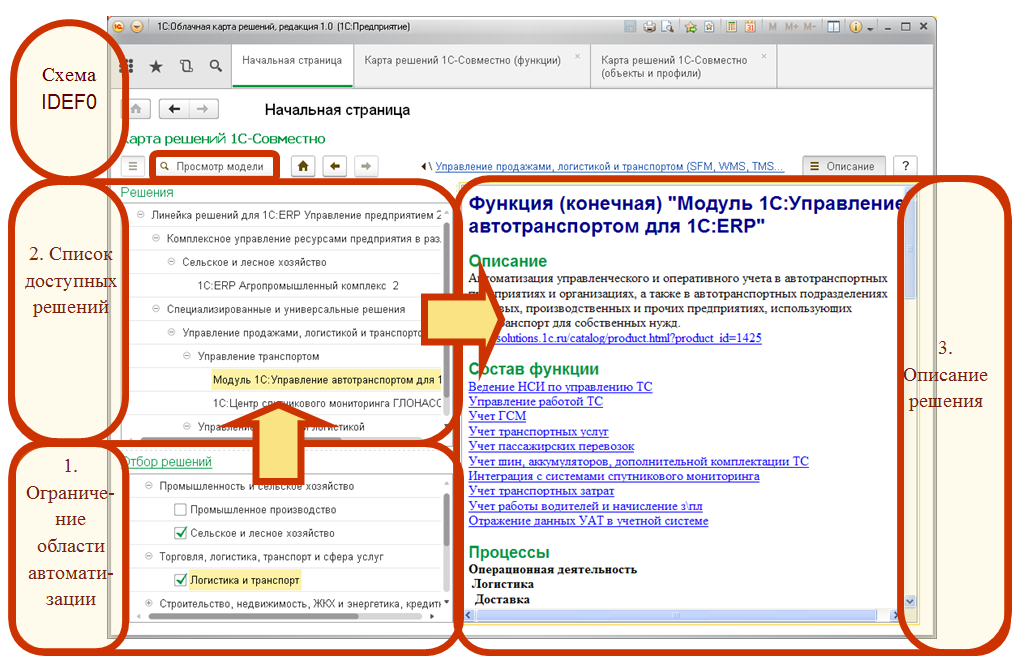
The 1C: Cloud Solution Map service provides access to functional models of a number of 1C solutions, as well as industry-specific and specialized solutions manufactured according to the 1C-Together scheme. Actualization of the functional model is provided by direct access to the web service of the DSS for Industry and Specialized Solutions database, the decision model of which is maintained up-to-date in accordance with the Modular Approach Concept in the 1C: ERP Enterprise Management 2 solution architecture.
The service supports following direct links to function schemes, for example:
For potential customers:
For users of 1C products:
The results of any project depend on the team. To develop a line of solutions for 1C: ERP, we managed to assemble a large team of professionals ready for experiments, ready to overcome difficulties together. Given the number of development partners, it is difficult to cite the full list, it would not be desirable to single out individual partners.
We consider that in the choice of partners, their competence of everyone in their field and synergies in achieving a single goal, we were not mistaken.
We have shared with you the key processes for developing a line of solutions for 1C: ERP. The whole process is quite complicated, including a large number of participants, both from our side and from the part of the development partners. First of all, I wanted to convey to the reader the processes of designing and monitoring the progress of such a complex project. We are applying this approach for the first time and hope to extend this experience to the development of other solution lines.
We hope that the results will please both the end users of our products and partners.
We would be happy to discuss our experience, get feedback on the proposed service. We will try to take into account the useful comments.
Industry and specialized products that extend the functionality of "1C: ERP Enterprise Management 2"
On the basis of our technological platform "1C: Enterprise 8", we ourselves, the 1C company, produce about 20 solutions of various caliber - from "Management of our company", "1C: Accounting" of different editions (from "Simplified" to "Corporate" ) until our most functionally rich solution is “1C: ERP Enterprise Management 2”.
“1C: ERP 2” is a solution that automates most of the processes of multi-disciplinary enterprises. But there are whole classes of tasks and industry characteristics that require more detailed study than it is in “1C: ERP 2” - trade, logistics, warehouse management, construction, agriculture, etc. It is not appropriate to include this functionality in a typical solution, since This will complicate the work of most users. In addition, we ourselves may not have enough resources to fully implement the required functionality.
So, we are faced with the task of creating industry / specialized solutions that:
')
- meet the needs of the market;
- are developed with the lowest possible use of the resources of the 1C company itself;
- have a guaranteed quality of implementation.
We solve this problem as follows:
- Solutions are created by our partners with expertise in the relevant field.
- From the company "1C" in the creation of the decision takes part "moderators" - the architects of the project, and curators of directions
- We have developed regulations for design and development of solutions to control product quality.
Products that extend the functionality of "1C: ERP", are produced in the framework of the project "1C-Together."
Cooperation with partners "1C-Together"
Under the 1C-Together project, the product is created by the partner of 1C, but the copyright holder is 1C. We ourselves define the requirements for the product and control its quality.
The procedure for developing joint solutions:
- We are looking for the market-demanded functionality that has not yet been implemented in our products, and make up the functional requirements for the new product;
- We announce a competition for the development of new “1C-Joint” solutions, as well as accept applications for product launches initiated by partners;
- We identify partners with the greatest competencies and willingness to long-term development of the direction;
- We order the partner the development, development and support of the product.
We monitor the quality level of our decisions. Thus, according to the survey data, the quality of the products themselves, the work of the partner, and the developer consulting line are evaluated:
Quality chart

The concept of a modular approach to the architecture of solutions based on "1C: ERP Enterprise Management 2"
From the point of view of the concept and architecture, “1C: ERP” is a completely new product compared to its predecessor, “1C: Manufacturing Enterprise Management”. One of the key differences of the new solution is the primacy of the management functions. In developing the line of industry and specialized solutions, it was important to support this in the 1C-Together solutions. Particular attention was paid to the problems of integrability of solutions among themselves and with “1C: ERP”, the possibility of building a unified information system consisting of a set of modules with a key integration core - “1C: ERP”.
The goal is a single seamless information management system built on the basis of “1C: ERP” and other solutions of “1C: Enterprise 8”:

The concept of a modular approach in the architecture of solutions based on 1C: ERP was developed. The concept defines the principles of development, unification and integration of various configurations within a unified management and accounting system.
All solutions within the 1C-Together program, expanding the capabilities of 1C: ERP, should follow the concept of a modular approach. The key objectives of the modular approach are:
- Forming a line of products that interact both at the level of the integration core “1C: ERP” and between themselves
- Simplify the creation of a single solution for users from a set of industry-specific and specialized solutions
- Minimization of labor costs for changing the composition of the modules of the solution and further support of the solution
- Elimination of duplication of common functional subsystems in various products

At the time of this writing, the number of already released line solutions is 31 (18 development partners), taking into account development plans, in Q2 2017. the number of solutions will reach 52 (24 development partners).
The process of designing, developing and monitoring industry and specialized solutions for 1C: ERP
Developer interaction in a single design environment
The work on the project involves geographically distributed and weakly related development teams. So, today in our work:
- 28 geographically distributed development teams;
- 44 active projects;
- 19 new solutions.
To control the quality of team work, we regulated the general principles of interaction between teams and projects:
- Analysis, design and documentation of functionality
- Formulating Requirements for Other Solutions
- Control the timing of the stages of design and development
- Solution Model Update
- Control of the declared functionality
- Discussion of requirements and wishes in the framework of the Round Table for Developers
A round table for developers of solutions "1C-Together" is held annually, this event discusses problems and proposals, organizes platforms for communication and interaction between development partners and developers of 1C: ERP.

View the image in full size
DSS for industry and specialized solutions (DSS PR / CP) - CASE-tool for joint design solutions
All solution developers interact through the product "1C: Design System for Applied Solutions" (abbreviated as DSS). DSS helps to design application solutions on the 1C: Enterprise platform and allows servicing the tasks of the full software development cycle - gathering requirements, controlling changes, documenting, bug tracking, etc. DSS is designed as a configuration on the 1C: Enterprise 8 platform.
DSS can be used as a tool for designing new information systems developed in the 1C: Enterprise 8 environment, as well as for describing and documenting existing systems developed previously without using DSS.
We have chosen DSS as the most convenient and suitable for our tasks and corresponding to the requirements we have put forward for the CASE-tool:
- Ability to build a complex system model
- Product Lifecycle Management
- Multiproject
- Customizability
- Integration with the development environment
- Accessibility for implementing partners 1C
As part of the development of the Solution Line for 1C: ERP, all project participants have access to a common DPR PR / CP cloud database, the work with which is determined by the regulations:
Goals
- Product Lifecycle Management
- Design and documentation of design solutions
- Monitoring Development Results
Tasks
- support of the current description of automated processes of enterprises and the functionality implemented for this
- verification of the integrity of a single model of all solutions
- control of project implementation dates
- control of functionality of configurations of the described model
- implementation of a unified design environment when working together a large number of developers

Product Lifecycle Management
The whole project is divided into functional areas (sections of the project), each section is supervised by the head of the direction from the "1C". Sections are filled with the functionality of solutions (products), and:
- the functionality of one section is not necessarily determined by one product,
- The functionality of the entire section can be developed by several development partners.
For solutions that implement the functionality of a single section of the project, special requirements are placed on the possibility of integration.
For the designed functionality, corresponding technical projects are created, with the appointment of those responsible on the part of the development partner. Within the framework of one technical project, it is possible to release at once several options for the delivery of functionality (in fact, the products themselves).
Each technical project is assigned a planned deadline for completion (managed and supervised by the head of the direction), and deadlines are set for the implementation of the technical project.
The development partner specifies the timing of the control points within the overall duration of the project. When the deadline for performing one of the steps is exceeded, the information falls under the control of the responsible manager. Also the responsible manager sees the deadlines for the implementation of each stage (including overdue). Each stage is completed by the agreement of the control point responsible.
We do not set goals to manage the development process on the side of partners. Each partner uses its own established methodology in the team. We control only the terms of the control points that are important for us and adjust the results with the necessary standards and regulations, and we also control their familiarity with them.
Within the framework of technical projects, not only work on the development of new functionality is planned and carried out, but also load tests, standardization of general functionality, minimization of changes to metadata objects of typical configuration.
Logical model of solutions in the methodology IDEF0
In the base of the DSS PR / CP, the functionality of all solutions of the line is described in one project. At the heart of logical design is the IDEF0 methodology.
The integrity and consistency of the functional model is moderated by the functional project architect appointed by 1C.
Description of DSS notation
In the framework of the DSS, basic concepts are interpreted as follows:
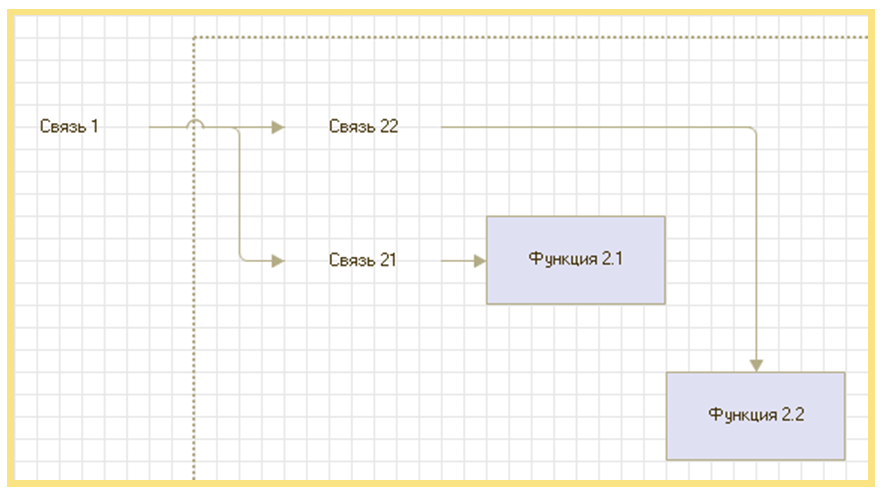
- Functional block (Activity Box) - some specific function of creating new information within the framework of the system in question
- Communication - information that is processed by the functional block (inputs and outputs) or otherwise affects the function (management and performing links - user profiles):
- The function input is the connection (information) consumed by the function. The diagram is reflected as an arrow pointing to the left side of the function block.
- The output of the function is the communication (information) generated by the execution of the function. The diagram is reflected as an arrow coming from the right side of the function block.
- Management (controlling effect on a function, a rule) - communication (information) analyzed for decision making within the framework of functions. The diagram is reflected in the form of an arrow to the upper side of the functional unit.
- Execution (user profile) - the impact on the function by one or more users of the system. The diagram is reflected in the form of an arrow to the upper side of the functional unit.

The functionality of all solutions is subject to verification in accordance with the verification rules, which are part of the audit mechanism of the model of the system being developed for compliance with the formal design rules. Thus, the integrity of the logical model of all solutions of the line is maintained.
Food Delivery Options
The concept of a modular approach allows for various options for the delivery of products:
- functionality in the "1C: ERP",
- functionality in the form of a self-running configuration,
- functionality for integration into "1C: ERP".
Moreover, within a single product, you can combine the functionality of different configurations. There are solutions that come with the functionality of up to 4 different configurations. This minimizes duplication of functionality.
For example, “1C: ERP Management of a construction organization 2” (partner - developer “1C-Rarus”) contains:
- Typical 1C: ERP functionality
- own original industry functionality
- functionality of individual solutions:
- "1C: Estimate 3",
- Module "1C: Realtor. Real estate sales management for 1C: ERP ",
- Module "1C: Rental and property management for 1C: ERP",
- Module "1C: Vehicle Management for 1C: ERP".
The integration capabilities, which are already at the level of logical modeling in the solution architecture, allow combining various configurations to produce targeted industry-specific solutions, for which it is enough to acquire the necessary modules.
Library of functional subsystems 1C-Together
In order to unify the solutions of the line, the general universal functionality is allocated and the “Library of functional subsystems 1C-Together” is formed.
The library provides a toolkit for developers of solutions "1C: Shared", containing a set of universal functional subsystems, ready sections for user documentation and technology for integration into industry and specialized solutions for the purpose of unification within a single line, which allows:
- To provide common approaches in the implementation of uniform universal mechanisms in the solutions "1C-Together";
- reduce the complexity of the release of new solutions through the use of ready-made functionality;
- simplify the integration of solutions from various development partners when combining configurations;
- reduce the number of different implementations of common mechanisms for users who simultaneously use multiple solutions.
The composition of library functions is moderated by the functional architect of the 1C project and is filled with development partners.
Notification of responsible technical projects
Given the large number of participants in development projects, monitoring tools are needed to notify those responsible about the progress of technical projects.
In the base of the DSS PR / CP, the regulatory tasks are set up, which form the distribution of letters. To this end, the following groups of recipients are distinguished:
- Responsible for the project
- Responsible for the sections of the project
- Responsible for technical projects
And types of mailings:
- Monitoring the implementation of technical projects - weekly
- Activity monitoring of development partners - weekly
- Notifications about the need to perform actions in the database (tasks, messages, etc.) - daily
- Notifications of errors in models - daily
Responsible persons receive e-mail reports such as:
- Deadlines for the implementation of control points (stages)
- Terms of technical projects
- Changes to metadata objects of typical configuration
- Errors and warnings in the model
- Actual tasks
- Work on the technical project
Report examples
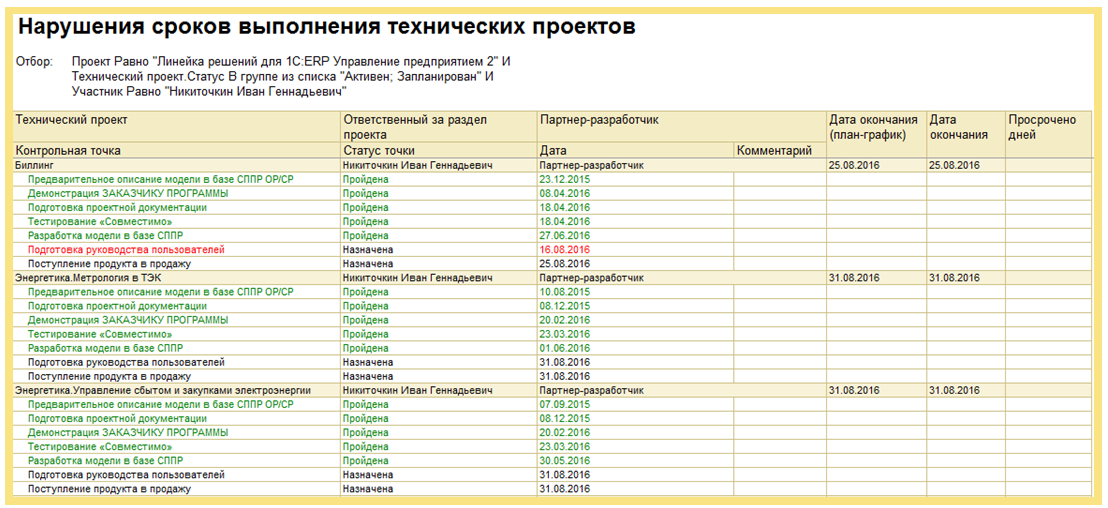
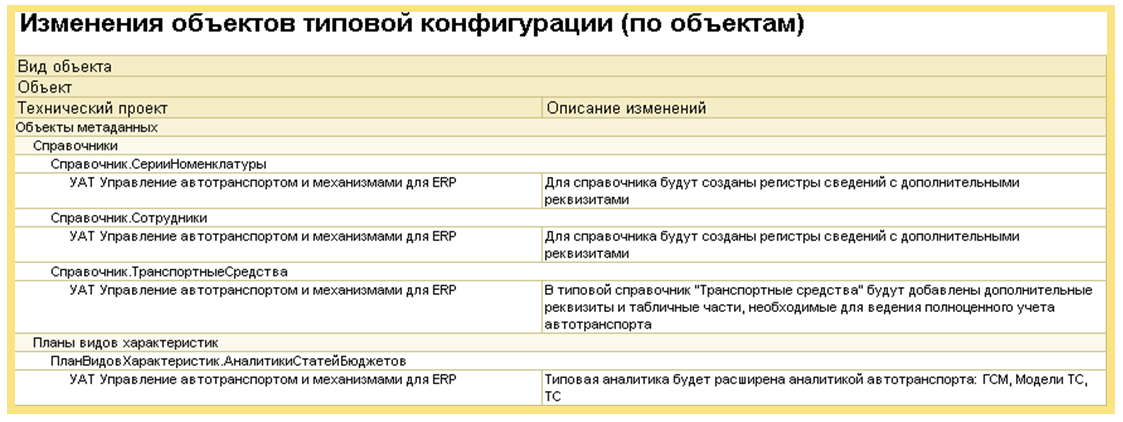





Preparing configurations for replication
General functional diagram of the pre-production verification solutions:

Pre-production verification is carried out within the framework of the regulations and includes both manual and automated verification of the materials transferred.
The development partner is responsible for the quality of testing, the completeness of the materials and transfers the materials to 1C for checking before release fully operational, tested, meeting the requirements of the 1C: Compatible certification, the System of Standards and Configuration Development Methods for the 1C: Enterprise 8 platform. and the requirements of the Rules of Cooperation with the developers of joint solutions.
The possibility of including additional checks for compliance with the functional model in the database of DSS OP / CP: control of the compliance of the declared functionality of the OP / CP with the implemented one and control of compliance with the modification of objects of a typical configuration declared in the DSS of the OP / CP is also being considered.
Service 1C: Cloud Map Solutions
For potential users of new solutions, you need to make a convenient and simple service, with easily accessible tools. For this purpose, a special web service and client were developed to display the schemas :

The 1C: Cloud Solution Map service provides access to functional models of a number of 1C solutions, as well as industry-specific and specialized solutions manufactured according to the 1C-Together scheme. Actualization of the functional model is provided by direct access to the web service of the DSS for Industry and Specialized Solutions database, the decision model of which is maintained up-to-date in accordance with the Modular Approach Concept in the 1C: ERP Enterprise Management 2 solution architecture.
The service supports following direct links to function schemes, for example:
- The function "Comprehensive information management system based on 1C: ERP Enterprise Management 2"
- Function "1C: PDM Engineering Data Management"
Benefits of using the service
For potential customers:
- Getting an idea of the functionality of ready-made solutions of the company "1C"
- Preparation of functional requirements for organizing competitions for automation projects
For users of 1C products:
- The study of the functionality of ready-made solutions for the automation of industry and specialized business processes, the definition of products containing the required functionality.
- Opportunity to choose a partner, get acquainted with the terms of the acquisition, information materials, successful implementation projects, as well as take part in the nearest events and get access to the demonstration base (if available) by going to the product page of the website http: //solutions.1c. ru
- Expansion of areas of automation within the framework of used solutions by studying and applying all the inherent functionality.
Use of service partners
- Demonstration to potential customers of a functional model of ready-made solutions (models contain detailed information on products, their functionality, automated business processes, workplaces). Demonstration to existing customers of the functionality of products containing industry specifics, the implementation of objective tasks.
- Participation in competitions, preparation of proposals: a comparison of the required functionality with the functionality of the entire complex of ready-made solutions. Selection of finished products to cover functional gaps. Preparation of proposals using examples of integration solutions and business cases of successful projects.
- Implementation: correlation of real enterprise processes with a functional model, the study of the principles of interaction of functional blocks.
Development team - a team of professionals
The results of any project depend on the team. To develop a line of solutions for 1C: ERP, we managed to assemble a large team of professionals ready for experiments, ready to overcome difficulties together. Given the number of development partners, it is difficult to cite the full list, it would not be desirable to single out individual partners.
We consider that in the choice of partners, their competence of everyone in their field and synergies in achieving a single goal, we were not mistaken.
Finally
We have shared with you the key processes for developing a line of solutions for 1C: ERP. The whole process is quite complicated, including a large number of participants, both from our side and from the part of the development partners. First of all, I wanted to convey to the reader the processes of designing and monitoring the progress of such a complex project. We are applying this approach for the first time and hope to extend this experience to the development of other solution lines.
We hope that the results will please both the end users of our products and partners.
We would be happy to discuss our experience, get feedback on the proposed service. We will try to take into account the useful comments.
Source: https://habr.com/ru/post/328966/
All Articles